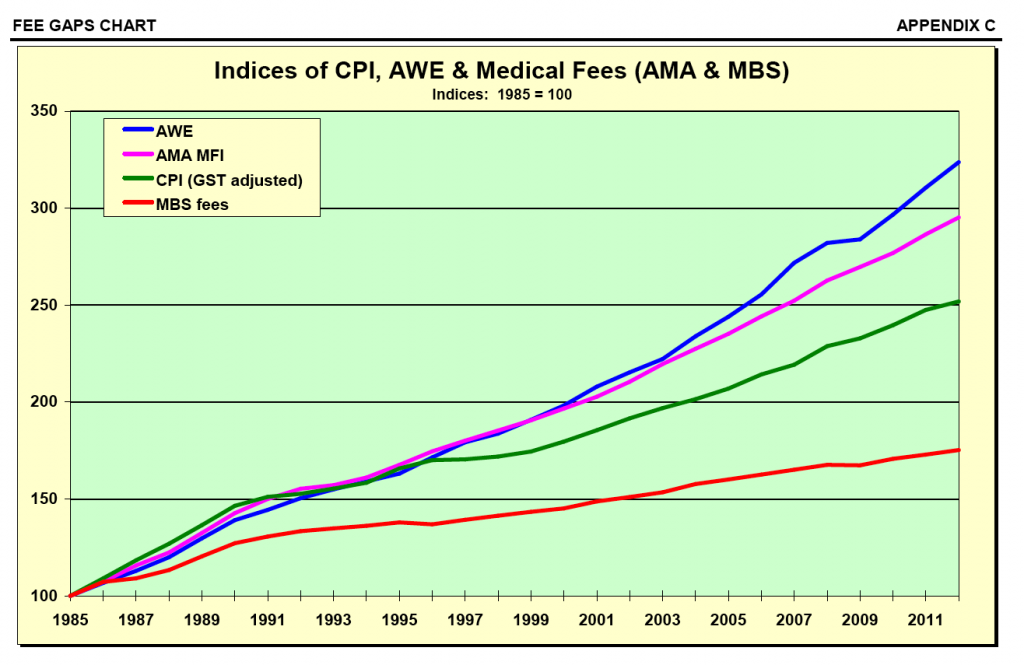The fees charged for your anaesthesia have been formulated in accordance with guidelines (Relative Value Guide) published by both the Australian Society of Anaesthetists (ASA) and the Australian Medical Association (AMA).
An independent arbitrator (Anderson Report), appointed by former Federal Health Minister Dr Carmen Lawrence (when Premier of Western Australia) determined that the AMA’s recommended Schedule of Fees (using its Medical Fees Index to update recommended fees) was the only economically justifiable medical fee schedule (not the Federal Government’s Medicare Benefits Schedule). Former Federal Health Minister, the Hon Tony Abbott, MHR, referred to the “mythical Schedule Fee” (Sunday television program 14 March 2004) as he acknowledged it bears no relationship to economic reality.
The rebates received from Medicare and your private fund are based on the Government Schedule of Benefits. Rebates from private funds were, for many years, capped by Government legislation. The Government’s suggested fee (Schedule Fee) in its Schedule of Benefits is not related to the true value of anaesthesia services for the following reasons:
- The Government suggests a fee level based solely on what the Government can politically afford to rebate to patients in any one year. In the words of the Commonwealth Auditor-General (Audit Report No.32, 1990-1991 — Administration of the Medicare Benefits Schedule): “The Schedule Fee simply represents the amount the Government, having regard to budgetary and economic considerations, is willing to pay for the provision of particular medical services”.
- Since the introduction of Medibank/Medicare in 1973 and up to November 2007, changes in Government regulated rebates have fallen far behind comparable community indices, viz (latest available rounded figures):
- Average Weekly Earnings have risen 12 times (Aug 2007) Consumer Price Index has risen 7 times (Sept 2007) Govt. Schedule Fees (Anaesthesia) have risen 5 times (Nov 2007)
- Both the 1996 and the 2003 Federal budgets actually decreed a 0.0% rise in any rebates for that coming year. This has continued the Government’s habit of totally ignoring rises in economic indices relevant to running a business. The 1996 budget also reduced, by a minimum of 10%, the rebates for many items. And again the Government also reduced anaesthesia rebates by 3.8% for the year 2002-2003 (November to November).
- Government regulated rebates have, therefore, quite obviously not risen sufficiently to cover rises in practice costs. The most notable cost rise being Medical Practice insurance — rising by over 14,000% for anaesthesia (and over 140,000.00% for some specialties) in just the last 22 years. A direct result of the modern excessive ‘consumerism’ mentality and not reflective of the fact that Australian anaesthesia actually has the safest figures in the world for morbidity and mortality. (It has been claimed to be two and a half times safer than in the U.S.A. or the U.K.).
- The Government significantly reduced Medicare rebates in 1987 and this action increased the chance of an account payable by the patient. Medicare rebates for in-patient services were reduced from 85% to 75% of the Medicare suggested fee and the $20 gap limit was also abolished.
- ASA and AMA suggested fees are determined by the degree of difficulty of anaesthesia, whether it takes place during or after normal working hours and the actual time taken for an operation. From November 2001, Government regulated rebates for individual anaesthetic services have been calculated using a similar system but, as expected, are based on Medicare’s under-adjusted monetary unit.
- Government regulated rebates and suggested fees for anaesthesia services do not reflect the equal training (total 14 years = 5-6 medical degree + 3 general hospital + 5 specialty training) and medical and legal responsibilities that the specialty of anaesthesia shares with the other medical and surgical specialties.
As a consequence of all the above factors, your combined rebates, in most cases, will only partially cover the fee.
Sources of Statistics:
- Australian Bureau of Statistics
- Australian Medical Association
- Australian and New Zealand College of Anaesthetists
- Department of the Parliamentary Library — Parliament of Australia
- Reports of Enquiries into Medical Fees for Medical Benefits Purposes
- Health Insurance Commission Data (Annual Reports)
This information has been sourced from the Australian Society of Anaesthetists.


